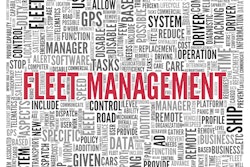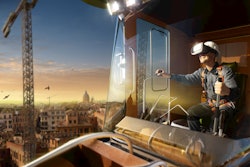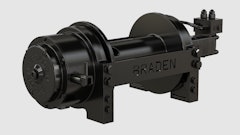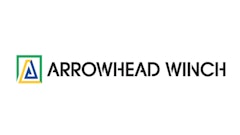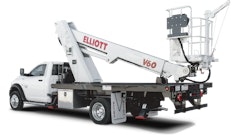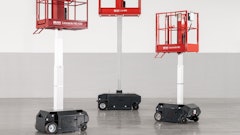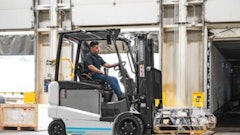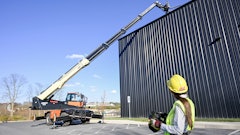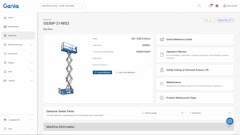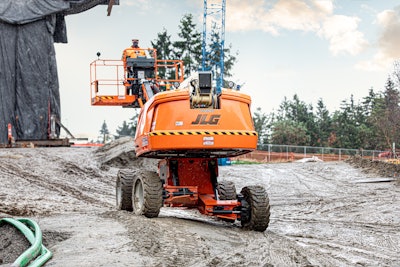
The most recent International Powered Access Federation Safety Report said falls from the platform are among the most common type of incidents leading to death on the jobsite—a finding that has remained consistent over the last decade, according to Malcolm Early, VP of marketing, Skyjack. Ensuring that equipment is safe, efficient and productive involves manufacturers listening to the operators and contractors and making design improvements to benefit the work on the jobsite.
Listening to End Users
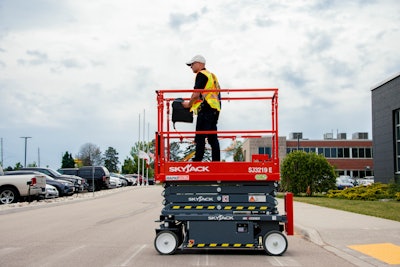 End users' need to reach tricky, confined spaces and the relatively common practice of operators standing on railings to gain more height inspired a tool to allow increased reach in a safe way.Skyjack
End users' need to reach tricky, confined spaces and the relatively common practice of operators standing on railings to gain more height inspired a tool to allow increased reach in a safe way.Skyjack
“Customer feedback is very important, and at Skyjack, machines are designed with the customer in mind. One is example is Skyjack’s XStep,” Early said. “Paired with customer feedback about the need to reach tricky, confined spaces and the relatively common practice of operators standing on railings to gain more height, it became clear that a tool to allow increased reach in a safe manner was needed. With XStep, working height is maximized and productivity is improved with increased access into and around difficult spaces such as ceiling mounted structures.”
Early said that the XStep provides operators with an additional 19 inches (48 centimeters) of jobsite access with the platform mounted securely on the mid rails. The design and height of the top railing and entry and exit via the locking gate ensures that operators have the same degree of security as a conventional platform.
Edwards agrees that end-user input is a critical component for innovation.
“At JLG, user feedback is the cornerstone of our innovation strategy, driving us to develop products and services that meet our customers' needs,” said Craig Edwards, vice president of strategic accounts, JLG.
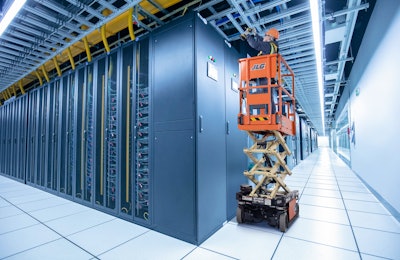 End users asked for a scissor lift that addressed the most common and costly pain points of owning and operating electric machines: Charging, battery maintenance and hydraulic leaks.JLG Industries
End users asked for a scissor lift that addressed the most common and costly pain points of owning and operating electric machines: Charging, battery maintenance and hydraulic leaks.JLG Industries
“The demand for green equipment has grown significantly ... Our customers are being tasked with doing more with less and doing so in a manner that is minimally disruptive to the environment,” Edwards said. “This led them to ask JLG to develop a scissor lift that addressed the most common and costly pain points of owning and operating these machines: Charging, battery maintenance and hydraulic leaks.”
According to Edwards, the team removed all the hydraulic and standard components found in a traditional scissor lift and replaced them with electrical and linear lift actuators. They also added a regeneration circuit in the lift system that uses gravity to charge the battery.
“When the lift descends, the result is a purely electromechanical machine with a single lithium-ion battery, a third of the size usually needed,” he said. “This provides all-day operation and can last the entire life of the machine.”
Customer feedback is also critical to Magni Telescopic Handlers, according to Joe Leinwol, Magni’s chief sales officer.
“Over the years, we've made several enhancements based on [customer] input, such as improving the safety features of our equipment, enhancing usability with more intuitive controls, and increasing the maximum heights and lift capacities of our machines.”
The company recently updated its Combi Touch System for its rotating telehandler and TH fixed boom telehandler lines. The update allows users to easily view all machine functions from a large screen.
In addition, “We've improved the ergonomic design of our cabs to reduce operator fatigue. By listening to our customers, we ensure that our products not only meet but exceed industry standards, providing them with the reliable and efficient equipment they need.”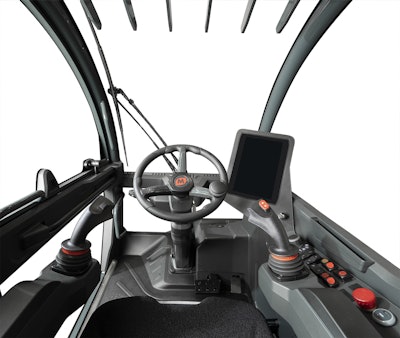 The ergonomic design of the Magni cabs was chosen to help reduce operator fatigue.Magni
The ergonomic design of the Magni cabs was chosen to help reduce operator fatigue.Magni
Selecting Wisely
Everything about a project should be considered when selecting or renting lift equipment, from the budget to the details of the work to be done. To improve efficiency and productivity, contractors need to ensure that they have just the right amount of machine for the work, not too much and not too little.
“Having too much machine for the job may not seem like a big deal, but rather than allowing you to do what you need to do and then some, using an oversized lift may restrict your access unnecessarily,” Edwards said. “For example, if you need to work indoors—particularly in narrow hallways or other tight spaces—a small low-level access lift or lightweight electric scissor lift is more effective than a large scissor.”
In addition, choosing a machine larger than you need may increase your costs unnecessarily. This includes the price of buying or renting a larger unit and the fuel and other maintenance costs that go along with it.
Selecting a machine that is too little brings its own problems. These include extending your timeline, extend your timeline because it takes longer to accomplish the tasks you need to get done.
“Make sure you consider how many workers and what kinds of tools and materials you need to carry to height before selecting a machine, Edwards said. “An appropriately sized machine will allow you to carry everything you need in fewer trips compared to a machine that’s too small.
Ensuring that you have the ideal horsepower and tires for rough terrain is also important.
“If you need to traverse especially soft or sensitive ground conditions, you may even consider a crawler-type machine,” Edwards said. “You’ll also want to make sure you have enough power to last an entire shift … if you select an electric machine, the runtime on a single charge should be a crucial factor in your decision.”
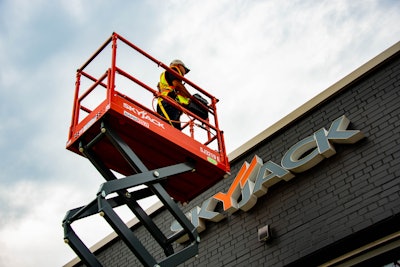 Total cost of ownership is another major factor in an equipment decision for boom and scissor lifts.Skyjack
Total cost of ownership is another major factor in an equipment decision for boom and scissor lifts.Skyjack
“Skyjack’s newest AC brushless electric drive scissors are 20% more efficient compared to hydraulic drive with a longer run time per charge and fewer lifetime charge cycles,” Early said.
When researching the options, Edwards recommends starting with getting the answers to the questions below:
- What is your budget? If you’re buying, be sure to consider the purchase price and overall total cost of ownership.
- At what height do you need to perform most of the work?
- How much weight do you need to carry to the work area?
- Are there space limitations to consider, including narrow doorways or hallways that the machine must fit through?
- What type and size of material or tools are you working with?
- Will you be working inside, outside or both?
- What types of surfaces and ground conditions will you need to navigate?
- Will you have access to a consistent power source to charge a machine if considering electric power?
- Are there diesel or propane requirements for indoor use at your facility?
- How long do you need the machine to operate based on shift schedules?
- Are there specific accessories that would be useful, like plumber’s or electrician’s racks?
- Are there any environmental or surrounding area regulations—like noise and emissions—that you need to comply with?
Lifting Smarter
Technology is optimizing operations and productivity in all construction equipment, including scissor and boom lifts.
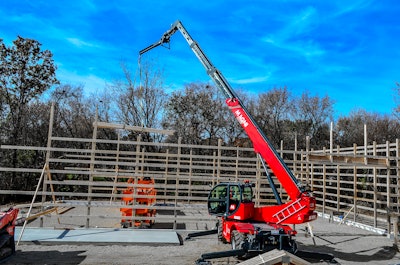 Advances like telematics and Internet-of-Things-enabled devices allow for real-time monitoring of equipment performance, predictive maintenance and improved fleet management.Magni
Advances like telematics and Internet-of-Things-enabled devices allow for real-time monitoring of equipment performance, predictive maintenance and improved fleet management.Magni
“Skyjack’s updated 40-foot and 60-foot booms have been redesigned to improve customer return by using SMARTORQUE technology and data-driven design,” Early said. “SMARTORQUE utilizes optimized gearing and a simplified, high-efficiency hydraulics package, so these models can employ 25-hp engines to deliver similar onsite job performance as higher-powered units.”
The trend of the connected jobsite affects lift equipment as well. Edwards agrees.
“Companies continue to move from one way connectivity found in today’s telematics to fully integrated two-way interactivity,” he said. “By better [using] the data, machine downtime can be minimized through remote diagnostics and troubleshooting, as well as predicting upcoming maintenance needs and proactively scheduling routine service, from installing software updates to stocking the right parts, at the right time, for quicker serviceability.”
Operating Safely
 Ensuring that equipment meets safety standards is paramount, and manufacturers make sure their equipment has the components to protect workers.JLG Industries
Ensuring that equipment meets safety standards is paramount, and manufacturers make sure their equipment has the components to protect workers.JLG Industries
In the U.S., the Occupational Safety and Health Administration (OSHA) regulation for aerial lifts [CFR 1926.453 (b)(2)(v)] requires occupants of an aerial work platform to wear a body belt with a lanyard attached to the boom or basket.
“As of January 1, 1998, OSHA’s fall protection rule requires using a full body boom lift harness for fall arrest in place of a body belt when working from an aerial work platform,” Edwards said. “The full body harness [is] attached [with] a lanyard to a lanyard anchorage point.”
Lanyard anchorage points must meet or exceed the OSHA 5,000-pound (2,273-kilogram) static pull test requirements. In addition, each point is usable by one person only.
“For JLG products designated for use with a 30-inch (76-centimeter) maximum lanyard length, a fall restraint system would prevent a person from falling out of the platform,” Edwards said. “It is important to keep the differences between arrest and restraint in mind: Fall arrest means to be caught while falling, while fall restraint means to be restrained from falling in the first place.”
As the construction industry embraces connectivity, safety and end-user input, lift equipment manufacturers will continue to improve machines to optimize operation and productivity. Remember, the best way to add your needs to equipment is communicating with your dealer or manufacturer.




